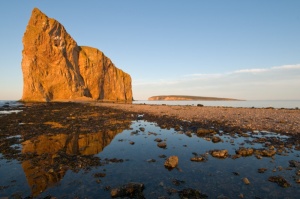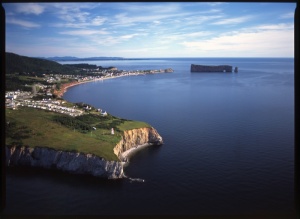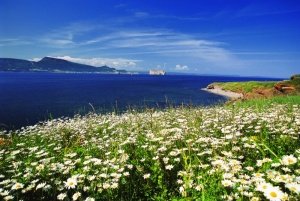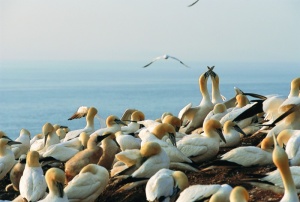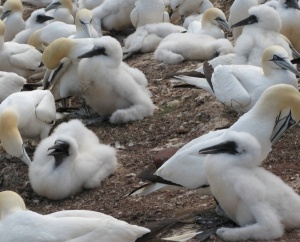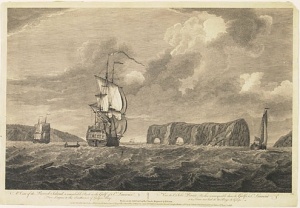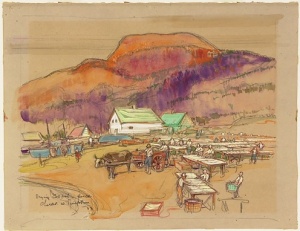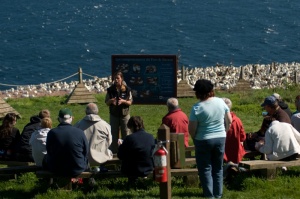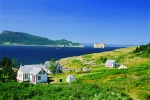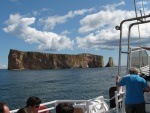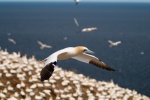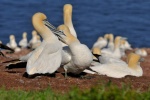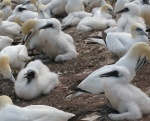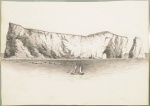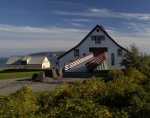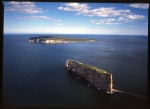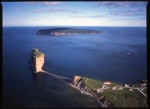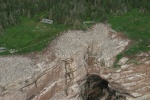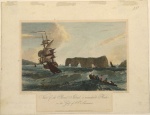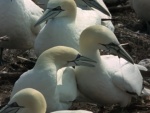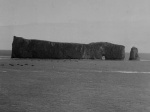Parc national de l’île Bonaventure et du Rocher Percé
par Chaillon, Corentin
Perched at the easternmost tip of the Gaspé Peninsula, Percé, with its unique and awe-inspiring geology, has garnered centuries of attention. With a landscap ecomposed of sheer cliffs, a giant limestone monolith, red soil and a white cape, Percé is an awe-inspiring marriage of sea and mountains that stands out as one of Quebec's natural wonders. Percé's centuries-old human history was marked first and foremost by the fishing industry and then by the tourist trade. Furthermore, the area houses two of Canada's natural heritage crown jewels: breath taking Percé Rock and Bonaventure Island, home to the world's largest colony of gannets. Parc National de l'île-Bonaventure-et-du-rocher-Percé was founded in 1985 to ensure that these exceptional natural assets would be protected for future generations.
Article disponible en français : Parc national de l’île Bonaventure et du rocher Percé
The Geological History of Bonaventure Island and Percé Rock
The park's geology is, without a doubt, its most famous and spectacular asset. It is impossible to see Percé Bay without being struck by its unique landforms that create a landscape which attracts tens of thousands of visitors each year and has become a symbol of tourism in Quebec.
Just metres from the beach stands Percé Rock, the area's most striking feature. It is massive - 475 metres long, 90 metres [295 feet] wide and 20 metres [66 feet] tall - and is pierced by a hole 20 metres in diameter. It is truly a majestic sight. What is even more incredible is that this enormous, five-million-ton sedimentary monolith is but a stone's throw from four other geological formations, all dating from different eras but stemming from the same ancient strata of geological sediment. The strata's initial layer dates back to over 600 million years ago and is known as the Precambrian Era, the very same period when the Appalachian Mountains were first formed. At the time, the mountains that now surround Percé formed the floor of an ancient ocean. They were thrust up and shaped by the shifting tectonic plates and then slowly eroded into their current shape.
Bonaventure Island's Wildlife Heritage
The area's geology is responsible for more than its unique appearance. In fact, the relatively isolated cliffs that form the coastline and the icy, fish-rich waters of the Gulf of St. Lawrence have made it a haven for seabirds. This is especially true of Bonaventure Island, where erosion of the horizontal strata in the island bedrock has produced countless nooks, crannies and ledges that are prime real estate for nesting aquatic birds. As a result, the island, which covers four square kilometres, is home to tens of thousands of gannets, guillemots, auks, razorbills, black-legged kittiwakes, puffins and seagulls.
But Bonaventure Island is more than an aquatic bird sanctuary. It is home to a variety of land birds as well, and there are virtually no predators. Each year, more than 250 of the region's 300 native bird species flock to the island. Such diversity-combined with excellent observation conditions -have made Bonaventure one of the top twelve ornithological sites in the world; which is good news for the many bird watchers who flock there each year.
Out of all of its winged guests, the northern gannet has emerged as the symbol of Bonaventure Island, thanks to its stateliness and the sheer size of its population. One of the park's roles is to protect and promote the island's gannet colony.
The Northern Gannet: A Star is Born
The Northern gannet (Morus bassanus) is the largest seabird in Canada. With a dazzling white plumage and contrasting black wingtips, a tinge of saffron on its head and icy blue eyes, the Northern gannet's appearance matches its spectacular power flight. [In French, the Northern gannet is known as the fou de Bassan because of its awkwardness on land and because the black band around its eyes recalls the masks worn bycourt jesters, known as fous.]
Like 95% of aquatic bird species, gannets nest in colonies. With its 62,000 couples, the colony on Bonaventure Island is an unforgettable sight. It is the largest and most accessible gannet colony in the world. Each year between May and October, the gannets return to Bonaventure to nest before flying back to the warm waters of the Gulf of Mexico for the winter. The densely-packed breeding colony formed by the birds in the summer offers tremendous biological advantages. Not only does it make it easier to guard against predators, but it also improves the rate of successful reproduction in a setting where the birds' primary food supply is "temporary" (the fish the birds feed on are only found in the Gulf during the summer months). Successful reproduction largely depends on the gannet's ability to raise its lone hatchling before running out of food. The social and reproductive impetus created by the presence of the other birds in the colony also causes females to lay their eggs earlier in the season, thus improving the chicks' chances for survival.
The Bonaventure Island colony stretches out over the highlands at the eastern end of the island, where particularly tall cliffs provide both protection and strong up draughts capable of supporting the heavy bird during takeoffs and landings (adult gannets weigh around three kilograms). While the colony may appear somewhat chaotic at first glance, nothing could be farther from the truth. In fact, it has a very well-defined organisational structure. Individually, each nest - a small mound of algae, twigs, and droppings - is 80 centimetres from its neighbour, which just happens to be the smallest distance needed to put each nest out of its neighbours' pecking range. This nearly mathematical layout has the advantage of optimizing available space while minimizing conflict. The colony is also organized at the group level. Only mature, breeding adults have a place in the centre of the colony; immature individuals (those aged six years and less) are relegated to the outer perimeter. By living alongside the more experienced birds, young gannets, whose colouring is darker, are able to spend a few years learning their future role as breeders through imitation. They also find their future breeding partner among the other single birds, for the gannet's monogamy is one of its defining characteristics. However, casting aside any romantic pretensions, it is not toits partner that the gannet is faithful, but rather to its nest (that is, its territory). However, since both members of a mated pair are faithful to a single nest, it naturally follows that they are faithful to one another. Thus, each summer, new pairs follow their neighbours and build new nests on the outer edge of the colony, always the same distance from the other nests, and so, the colony continues to grow until it cannot support any new arrivals.
Percé Bay: A Brief History
Although the Bonaventure Island gannet colony is so large that it seems everlasting, it has not always existed. At the very least, the first sailors who stopped in Percé Bay didn't mention it. In fact, the first recorded reference to gannets in the area only dates back to 1860.
The first Europeans to visit the bay were fishermen who, faced with dwindling supplies of fish in the waters around the Old World, ventured over to the shores of Newfoundland and the Gaspé for their bountiful cod reserves (which were long thought to be inexhaustible). Norman, Breton, Basque and Charentais fishermen would begin preparing for their transatlantic voyages in late March. The first captain to arrive would oversee the fishing community's operations for the season. Come fall, the fishing vessels would set sail for Europe, their holds full of famous North Americandry salted cod.
A lack of written history and lasting evidence means that very little is known about the history of the bay's occupation prior to the arrival of the earliest European fishermen. What is known is that members of the Mi'kmaq nation were already living in the Gaspé, travelling the peninsula with the changing seasons and hunting and fishing. Close ties were formed very early on between fishermen and the Amerindian locals, on whom they relied for everything, from obtaining meat and fur to watching over fishing equipment left behind when they returned to Europe for the winter.
The French Regime
In the spring of 1534, Jacques Cartier sailed along the coast of Chaleur Bay, looking for a passage to the Orient. On July 24th of the same year, he came ashore in Gaspé and officially claimed the land in the name of the King of France.
As a result of the steady growth of Acadia and New France, fishing activities in Percé intensified after 1604, despite a few run-ins with the English. The burden of managing Percé's permanent fishing establishment was originally the responsibility of Nicolas Denys, lord of the Seigneurial fiefdom of Percé, which was eventually passed on to his nephew. It was however an arduous task: for the area was far removed from major population centres and services; the soil was arid; and the available financial resources were limited. The venture, which was prosperous in the beginning, slowly collapsed and few chose to settle permanently in the area. Despite all this, the fishing industry continued to flourish and Bonaventure Island emerged as the largest fishing centre in the Gulf, with more than 600 fishermen working there during the summer.
However, privateers hired by the English attacked the coast in 1690 and againin 1702, completely destroying the fishing establishments along the Gaspé coast and effectively wiping out all previous efforts at colonization. As a result ofthe tension between the French and the English, almost a hundred years would pass before Bonaventure Island was settled again.
The English Regime
England's conquest of new France was made official in 1763, with the signing ofthe Treaty of Paris. In Percé Bay, things changed gradually. While fishermen from Lower Canada (formerly New France) and Acadia continued to produce ther egion's famous dry salted cod (the celebrated "Gaspé cure"), it was now Channel Island businessmen who were in charge of the lucrative trade. Fishermen also slowly began settling along the coasts of the Gaspé, something that had never happened with any degree of permanence in the days of Nicolas Denys and his nephew. The Jersey Island companies owed their success to a strategy based on four fundamental points:
- Erecting a general store that sold staple items, thereby encouraging a local population to settle permanently;
- Providing their own fleet of merchant ships;
- Developing a vast distribution network adapted to the varying quality of cod produced (top-quality product was shipped to Europe, while lower-quality cod was exported to the American colonies);
- Most importantly, creating a system of credit by which fishermen and their families slowly became indebted (and thus subservient) to the company;
At the time, cod fishing was a difficult and dangerous activity, as the names given to certain fishing banks (such as the Bancdes Orphelins [Orphan's Bank]) certainly seem to suggest. But while fishermen were out perishing on high seas or floundering in debt, the prosperous Jersey Island companies in Percé Bay were taking the lion's share of the profits of this lucrative business. The first such company, the Charles Robin Company, was the industry leader until the late 19th century, having established a number of fishing posts throughout the Gaspé Peninsula. Bolstered by their success, some of the managers of these posts left "Robin's" to strike out on their own. It was thus that that the John Le Boutillier Company was founded. The company set up shop in Percé and throughout the region and, likewise, the Le Boutillier Brothers Company (founded by one John LeBoutillier's cousins) also had one of its fishing posts on Bonaventure Island. Buildings owned by the latter are still found on the island and are open tovisitors. Of course, there were others; cod was plentiful in the Gulf and the hope of striking it rich attracted many businessmen, such as Duval, Hyman and Janvrin, to name but a few.
The population of Bonaventure Island, which was predominantly English-speaking until the mid-19th century, was vibrant and self-sufficient. Locals worked the land, collected gannet eggs and gathered firewood. The presence of a general store whose practices were more lenient than elsewhere, as well as the lack ofwell-established religious authorities meant that life on the island was more enjoyable than on the nearby mainland.
The Modern Era
The overly conservative Jersey Island companies were however too slow to adapt to new technology introduced in the early 20th century and so they eventually fell behind. They were victim to technological innovations such as modern netting techniques, mechanisation and the use of refrigerated ships that allowed cod filets to be exported fresh, thus fetching a higher price than dry salted cod. This technological revolution, along with the Great Depression, eventually spelled the end of the once-prosperous fishing companies. Although,the nascent tourism industry helped diversify Percé's economy, the same cannot be said of Bonaventure Island, which relied exclusively on the fisheries. And so, its population dwindled. According to the 1831 census, there were 172 permanent residents on the island, but only a handful remained a century later. By 1967, no one lived on Bonaventure year-round. The few, mostly foreign property owners that remained were expropriated in 1970, when the Quebec government purchased the island to transform it into a bird sanctuary.
Founded in 1985, Parc National de l'île-Bonaventure-et-du-Rocher-Percé, is not only limited to its original goal of conservation. Instead, the government (today under the auspices of the Société des Établissements de Plein air du Québec, or SÉPAQ) has taken upon itself to ensure that the park's extraordinary treasures remain available to the public in a sustainable way. Furthermore, by creating a large-scale educational program, the park has fulfilled another of its goals: education, which is the only way to truly guarantee that this exceptional natural heritage is preserved for years to come.
Today, the park welcomes over 60,000 visitors from around the world each year that come to admire Percé Rock and enjoy the fruit of the impressive heritage building restoration efforts carried out on Bonaventure Island, as well as to take in the unforgettable spectacle of the gannet colonies.
Corentin Chaillon
Biologist
Wildlife illustrator
BIBLIOGRAPHY
Lévesque, M., Synthèse des connaissances - Parc National de l'île Bonaventure et du rocher percé, SEPAQ, 2004.
Plourde, R. and C. Soucy, L'île Bonaventure, Une histoire au pays de la pêche. Le contexte historique, l'organisation de la pêche, les étapes du peuplement. Ministère du loisir, de la chasse et de la pêche, 1990, 122 p.
Pelletier, C., Notion de morphologie et d'écologie des oiseaux marins qui vivent à l'interieur de limites du parc de l'île Bonaventure et du rocher Percé. Ministère de l'environnement et de la faune, direction général de la Gaspésie-Île-de-la-Madeleine, 1998, 139 p.
Nelson B., The Gannet Buteo Books, USA, 1978, 336 p.
McGerrigle, H.W., L'Histoire géologique de la région de Percé. Ministère des richesses naturelles, Direction général des mines, 1968, 34 p.
Lageux, L., Le fou de Bassan de l'île Bonaventure, Club des ornithologue de Percé, 1985, 80 p.
Bisson, M., Historique de l'île Bonaventure, Ministère du tourisme de la chasse et de la pêche, ministère des affaires culturelles, Québec, 1997, 172 p.

